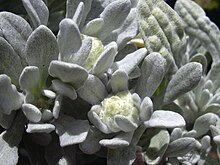| Gnaphalium | |
|---|---|

| |
| Scientific classification | |
| Kingdom: | Plantae |
| Clade: | Tracheophytes |
| Clade: | Angiosperms |
| Clade: | Eudicots |
| Clade: | Asterids |
| Order: | Asterales |
| Family: | Asteraceae |
| Subfamily: | Asteroideae |
| Tribe: | Gnaphalieae |
| Genus: | Gnaphalium L. (1753) not Adans. (1763) |
| Type species | |
| Gnaphalium luteoalbum[1][2] | |
| Synonyms[3] | |
| |
Gnaphalium is a genus of flowering plants in the family Asteraceae,[2][4] commonly called cudweeds. They are widespread and common in temperate regions, although some are found on tropical mountains or in the subtropical regions of the world.
Species[edit]
As of April 2023[update], Plants of the World Online accepted the following species:[5]
- Gnaphalium austroafricanum Hilliard
- Gnaphalium capense Hilliard
- Gnaphalium chiliastrum (Mattf.) P.Royen
- Gnaphalium chimborazense Hieron.
- Gnaphalium clemensiae Mattf.
- Gnaphalium confine Harv.
- Gnaphalium declinatum L.f.
- Gnaphalium demidium (O.Hoffm.) Hilliard & B.L.Burtt
- Gnaphalium diamantinense Paul G.Wilson
- Gnaphalium diminutivum Phil.
- Gnaphalium englerianum (O.Hoffm.) Hilliard & B.L.Burtt
- Gnaphalium exilifolium A.Nelson
- Gnaphalium filagopsis Hilliard & B.L.Burtt
- Gnaphalium flavocephalum G.L.Nesom
- Gnaphalium genevoisi Emb.
- Gnaphalium gnaphalodes (DC.) Hilliard & B.L.Burtt
- Gnaphalium griquense Hilliard & B.L.Burtt
- Gnaphalium heleios P.Royen
- Gnaphalium indutum Hook.f.
- Gnaphalium limicola Hilliard
- Gnaphalium lycopodium Pers.
- Gnaphalium maclovianum Gand.
- Gnaphalium magellanicum Sch.Bip.
- Gnaphalium nelsonii Burtt Davy
- Gnaphalium palustre Nutt.
- Gnaphalium pauciflorum DC.
- Gnaphalium peguense R.Kr.Singh
- Gnaphalium phaeolepis Phil.
- Gnaphalium pilulare Wahlenb.
- Gnaphalium polycaulon Pers.
- Gnaphalium pseudohelichrysum Reiche
- Gnaphalium puberulum DC.
- Gnaphalium rossicum Kirp.
- Gnaphalium rosulatum S.Moore
- Gnaphalium sepositum Benoist
- Gnaphalium simii (Bolus) Hilliard & B.L.Burtt
- Gnaphalium stewartii C.B.Clarke ex Hook.f.
- Gnaphalium uliginosum L.
- Gnaphalium unionis Sch.Bip. ex Hochst.
Some former species[edit]
- Gnaphalium dysodes → Pseudognaphalium dysodes
- Gnaphalium ecuadorense → Pseudognaphalium cheiranthifolium
- Gnaphalium norvegicum → Omalotheca norvegica
- Gnaphalium sylvaticum → Omalotheca sylvatica
Formerly included[edit]
Numerous species have at one time been included in Gnaphalium,[3] but are now considered to belong to other genera: Achyrocline, Aliella, Ammobium, Anaphalioides, Anaphalis, Anaxeton, Antennaria, Argyrotegium, Belloa, Berroa, Blumea, Castroviejoa, Chevreulia, Chionolaena, Chrysocephalum, Dolichothrix, Edmondia, Euchiton, Ewartia, Facelis, Filago, Galeomma, Gamochaeta, Gnomophalium, Helichrysum, Ifloga, Laphangium, Lasiopogon, Leontonyx, Leontopodium, Leucogenes, Logfia, Lucilia, Luciliocline, Metalasia, Micropsis, Neojeffreya, Novenia, Ozothamnus, Pentzia, Petalacte, Phagnalon, Pilosella, Plecostachys, Pseudognaphalium, Pterocaulon, Rhodanthe, Raoulia, Schizogyne, Staehelina, Stuckertiella, Syncarpha, Troglophyton, Vellereophyton, Xerochrysum
Secondary metabolites[edit]
Gnaphalium species are known to contain flavonoids and diterpenes. Recently, two unique caffeoyl-D-glucaric acid derivatives, leontopodic acid and leontopodic acid B formerly only known from Leontopodium alpinum (L.) Cass. were detected in various species of Gnaphalium together with similar formerly unknown compounds.[6]
References[edit]
- ^ lectotype designated by Britton & Brown, Illustrated Flora of North America 3: 453. 1913
- ^ a b Tropicos, Gnaphalium L.
- ^ a b Flann, C (ed) 2009+ Global Compositae Checklist search for Gnaphalium
- ^ Linnaeus, Carl von. 1753. Species Plantarum 2: 850-857 in Latin
- ^ "Gnaphalium L." Plants of the World Online. Royal Botanic Gardens, Kew. Retrieved 2023-04-20.
- ^ Cicek, S; Untersulzner, C; Schwaiger, S; Zidorn, C (July 2012). "Caffeoyl-D-glucaric acid derivatives in the genus Gnaphalium (Asteraceae: Gnaphalieae)" (Free full text). Records of Natural Products (Gebze-Kocaeli, Türkiye). 6 (3): 311–315. ISSN 1307-6167.
External links[edit]
 Media related to Gnaphalium at Wikimedia Commons
Media related to Gnaphalium at Wikimedia Commons Data related to Gnaphalium at Wikispecies
Data related to Gnaphalium at Wikispecies- Jepson Manual Treatment
- United States Department of Agriculture PLANTS Profile for Gnaphalium